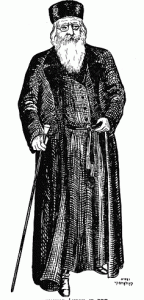Barbara Fischkin aptly described Felshtin as “a Ukrainian Petticoat Junction.” (1)
Indeed, for centuries the shtetl was barely touched by popular culture or technology. Yet during the 19th century, Felshtin managed to produce — if we may be permitted another anachronism — one “superstar.”
By virtue of his pedigree, intellect, and character, Rabbi Yisroel Kitover was probably the most revered Felshtiner of the past two centuries.

Although kitover literarily means someone who comes from the town of Kuty, or Kitev, the Kitovers were also members of a well-known rabbinical family descended, by marriage, from the B’aal Shem Tov, the founder of Hasidic Judaism. This alone was sufficient to command the respect of fellow Felshtiners. In fact, a half century after moving to the United States, Felshtin-born Erwin Biser proudly pointed out his own Kitover family ties and distant relationship to the B’aal Shem Tov.
His distinguished ancestry was not, however, what made Rabbi Yisroel Kitover Felshtin’s superstar. From the Felshtin yizkor book we learn that his dedication to his fellow Felshtiners, personal sacrifice, and exceptional intellectual gifts won great admiration in Felshtin and throughout the region.
Much of what is known about Rabbi Kitover comes from Shmuel Landau’s profile, “Thirty Years of the Rabbinate,” in the Felshtin yizkor book published in New York in 1937. (2)
Landau recounted that Yisroel, son of a Felshtin watchmaker, assumed Felshtin’s rabbinical seat in 1880. In contrast to his brother, Reb Shabse, Yisroel was not afraid to explore works beyond the Talmud and its commentaries. His studies encompassed many other works of philosophy and poetry, despite the fact it was forbidden for a young Hasidic man to read such books.
Landau also revealed that Rabbi Yisroel authored two published books, Birurei Hamidos, a commentary on he book by Aristotle, and Shvilei Emunah, a commentary on a book by Rabbi Saadye Gaon. (3)
After he was married, to support his family Yisroel accepted a position as a teacher for a wealthy resident of the village of Chipelvoff in Besaravia. “He was given very nice lodgings and generous wages. Reb Yisroel studied with a wealthy man’s two sons for twenty years, and they became the greatest scholars in the entire Besaravia region,” Landau noted.
Upon the death of Felshtin’s rabbi in 1880, a committee of Felshtiners asked Rabbi Yisroel to return to his birthplace and become the new rabbi. Landau recounted the dilemma Kitover faced.
Not surprisingly, the the rabbi’s intellect interests extended far beyond his shtetl, and his concerns included politics as well as religion. He was an early Zionist. According to Landau, “He was one of the first orthodox rabbis to consider the politics of Zionism a solution for the Jewish problem.” He convened a conference in Warsaw of some of the greatest rabbis of the day, inspiring them with a comparison of Zionism to a prophecy of Isaiah. Zion can only redeem its people after the Jews rebuild the land of Israel, he argued.
Rabbi Yisroel Kitover died in old age about 1910. Berel Baum recalled that “Felshtin grieved as if the entire town had been demolished.” Fortunately, Rabbi Kitover never lived to see the brutal pogrom that devastated his beloved town and claimed the lives of his son and grandson.
Yisroel’s employer “promised to sustain him and his family for the rest of his life. Reb Yisroel knew that in Felshtin he would barely have bread and water, and the Felshtiners would not be able to sustain him even partially.” Yet he chose service to his fellow townspeople over financial security and returned to Felshtin.
Kitover loved his fellow Felshtiners and accepted his newly acquired poverty without complaint. He was particularly skilled at motivating young students to study the Talmud, always making his time and large library available.
Notes:
1. “Reconstructing Felshtin,” Barbara Fischkin, Newsday. February 28, 1999, reprinted on www.felshtin.org.
2. From: Felshteen; zamulbukh lekoved tsum ondenk fun di Felshteener kdoyshim Felshteen; in memory of all those who were killed in the Pogroms of Felshteen in the year 1919), Posy- Shoulson Press, New York, 1937, 670 pp. Translation by Sora Ludmir for the Felshtin Society.
3. See the Felshtin bibliography for more details, www.felshtin.org.